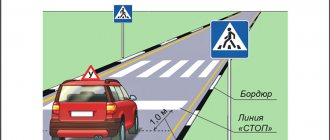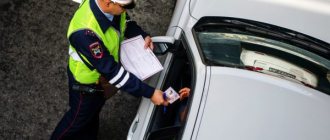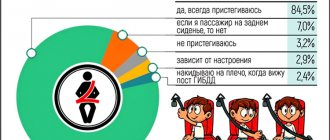Road safety regulations change almost every day. Accordingly, fines for violators are increased or decreased. Most often, drivers violate paragraph 2.1.2 of the traffic rules and are held accountable for not wearing a seat belt. What does the car owner and his passengers face for this violation in 2019?
- 2 Fines for not wearing a seat belt in 2021
2.1 Repeated violations
- 4.1 Is it possible to challenge a fine?
4.1.1 Video: procedure for challenging traffic fines
Background
The first fine for not having a car seat for a child, 500 rubles, was introduced in 2007. Since that time, it has increased several times, and by 2021 it amounted to 3,000 rubles. up to 100,000 rubles, depending on a number of accompanying circumstances.
Standards for the safe passage of children in vehicles were prescribed in the traffic rules back in 1993. According to them, the possibility of transporting a child in the back or front seat of a car was regulated. They established criteria under which standard seat belts could be used, or whether additional means were required.
Driver fines
In 2018-2019, the fine for driving with a driver’s seat belt unfastened is one thousand rubles, but if the driver manages to pay for the offense within a certain time frame (20 days from the date of imposition), it will cost him 500 rubles.
Some drivers simply throw on the seat belt. If this is discovered by the traffic police, the driver will also be punished by a fine, since it is not at all a defense in a collision. During a stop, a person does not have to wear a seat belt, but it is recommended if other vehicles are moving nearby. Traffic police officers can issue fines for this offense an unlimited number of times.
Rules for the safe passage of children in motor vehicles
Rules for the passage of children in motor vehicles place full responsibility for their observance on adults. According to them, there are separate standards for transporting a child in the rear or front car seat.
Children can ride in the front seat of a car if the following conditions are met:
- if a child is over twelve years old, weighs 36 kg or more, and is at least 150 cm tall, he can ride in the front seat of a car, fastened with regular car seat belts;
- If a child is under twelve years old, weighs less than 36 kg, and is not 150 cm tall, he can ride in the front using assistive safety devices (car seats and their equivalents).
Safe passage of children in the back seat of a car requires the following conditions:
- if the child is twelve years old, his weight and height have reached the required parameters (150 cm, 36 kg), he can ride in the back seat of a car, fastened with regular seat belts;
- If a child is under twelve years old, weighs less than 36 kg, and is not 150 cm tall, he can ride in the back seat of a car using additional safety equipment (child car seat and similar).
The use of auxiliary safety devices that are inappropriate for the weight, age and height of the child, according to the traffic rules, is perceived as a lack of necessary safety devices.
Who is responsible for an unbelted child in a car?
Separately, the question of who should be responsible for the fact that a child in a car is not fastened, the position of the legislation is quite strict: the driver must be responsible for the offense, because it is he who must monitor the safety of passengers in the car, and for their compliance with all traffic rules.
The application of this rule is due to several reasons:
- According to the norms of Russian legislation, only a citizen who has reached the age of 16 can be brought to administrative responsibility. Therefore, children under the age of 12 who are not properly restrained in a car cannot be punished.
- The driver transports children in the car, so it is he who must be responsible for their movement inside the vehicle; accordingly, it is he who bears responsibility for all violations committed during this activity.
Moreover, it is worth remembering that you will have to pay not only for your child. If a person placed children in the cabin of his vehicle who were not properly restrained, then the above amount will still be paid by the driver, and not by the child’s parents. The legislator does not allow other interpretations.
How much is the fine for a child seat in 2021?
There are several degrees of responsibility for failure to comply with the standards for the safe transportation of children in vehicles.
| The person who committed the violation | Penalties (RUB) |
| Individual – parents, relatives, acquaintances, etc. | 3 000 |
| Official - taxi driver, teacher, educator, etc. | 25 000 |
| Organization – educational institution, organization performing passenger transportation, etc. | 100 000 |
Individuals belonging to different groups may be subject to separate liability for violating the standards for the safe transportation of a child.
In the case of a trip in a taxi that is not suitable for transporting a child, the fine for driving without a child seat in the car will be paid by both the driver (25,000 rubles) and the passenger accompanying the child - a parent, relative (3,000 rubles) or a teacher, educator ( 25,000 rub.).
If there are clear signs of violation of the standards for the safe transportation of children, the organization providing transportation may be additionally held liable.
Traffic police fine for an unbelted child in a child seat
If a child is in a car seat while a vehicle is moving without securing it, it is equivalent to the absence of a car seat. The penalty for an unbelted child is the same as the penalty for a child without a child seat . (from 3,000 rubles to 100,000 rubles).
In addition, penalties are possible in the following cases:
- a child in the arms of an adult while the car is moving (it does not matter whether the child and passenger are buckled up or not);
- the car seat is clearly not suitable for the child’s body type;
- there is more than one child in/on the car seat;
- the car seat is not secured.
Regulatory acts regulating the safety of children while traveling by car
The basic standards for the safe transportation of children are prescribed in the traffic rules (clause 22.9). Violation of the norms prescribed in the traffic rules falls under the jurisdiction of the Administrative Code of Russia, part 3, article 12.23.
If the child is under twelve years old, but has reached the height and weight required for safe use of standard car seat belts, the situation is regulated by the norms of the administrative code prescribed in Article 12.6. (Regulation on penalties for a passenger not wearing seat belts - 1000 rubles).
In the event of an accident that causes harm to the health of a child, the situation may be regulated by the provisions of Article 238 of the Criminal Code. The amount of penalties under this article can be up to 500 thousand rubles.
Are there sanctions for the absence of belts in the cabin?
There is another type of punishment for drivers and passengers for not fastening their seat belts. It applies to those vehicles that were not originally structurally equipped with them. This category also includes those cars from which the belts and fasteners were removed by the owner.
However, in terms of administrative responsibility, drivers of such cars receive different protocols:
- if the car is not equipped with belts for various reasons (retro model, exclusive release, flagship, etc.), then the inspector cannot make claims to the driver and hold him accountable;
- however, if the belts were removed by the owner himself, then the driver and passengers will be fined 500 rubles.
Old cars were not structurally equipped with seat belts
What is the penalty for transporting several children without car seats?
Transporting several children who are under twelve years of age and under the required height and weight without additional safety devices is considered one offense. The punishment for it is not cumulative based on the number of children and is equal to the sanctions for the absence of a child car seat (3,000 rubles).
Fine for a child without a child seat in a taxi
If a traffic police inspector stops an ordinary driver who is transporting a small child in his car without a seat, then he faces liability under Article 12.23 of the Code of Administrative Offenses and a fine of 3,000 rubles.
It’s another matter if such a violation is committed by a taxi who is engaged in his activity professionally and has the appropriate permits and travels in a taxi car.
In this case, the driver may be charged under Article 238 of the Criminal Code of the Russian Federation - “Provision of services that do not meet the requirements for the safety of life or health of consumers.”
- Under the first part of this article, you can receive a fine of up to 300 thousand rubles , or restriction of freedom or even imprisonment for up to 2 years.
- According to the second part of the same article, if the case involved children under 6 years of age, or the consequences were the infliction of serious harm or the death of a person, the sanctions for the driver will be even tougher. The fine for a child without a car seat in a taxi is from 100 to 500 thousand rubles , or imprisonment for up to 6 years (!), with a fine of up to 500 thousand rubles.
- Part three of Article 238 of the Criminal Code of the Russian Federation is the most stringent and is applied if, for example, an accident results in the death of two or more persons. Sanction: up to 10 years in prison.
That is, if, for example, a taxi driver has an outstanding criminal record, and if he is caught violating Part 1 of Art. 238 of the Criminal Code of the Russian Federation (simply transporting a child without a seat), then the judge can easily send him to jail, according to the law.
Even worse, if an accident occurs (even if the taxi driver was not at fault, they drove into him) and it turns out that the taxi driver was transporting children with disabilities, and they, God forbid, were injured, the corresponding article of the Criminal Code will inevitably be applied to the driver.
How can a traffic police inspector check for the presence of a car seat?
Many people are familiar with the situation when an inspector opens car doors on his own to check whether passengers are wearing seat belts and/or whether children are in child car seats.
Of course, this is illegal - the Administrative Regulations of the Ministry of Internal Affairs describe any procedure for identifying an offense and prescribes for most of them (except visual) its own procedure, including a preliminary appropriate protocol. In this case, in order to open the doors, the inspector needs to draw up an inspection protocol with the relevant grounds included in it, a video recording or an invitation to two witnesses.
But more often than not, the inspector himself asks the driver to open the door in a demanding tone. In this case, he again only asks, and the request can be refused . If he requires this, then ask under what administrative procedure such a requirement was made. However, of course, it is always better to open the doors if there is no violation on your part.
Types of devices for the safe passage of children in motor vehicles (car seats and analogues)
Standards for safe travel in a child's car require that the child be secured in the seat. Fixation using standard seat belts, due to the physiological characteristics of the child, is not always sufficient and safe. Requires the use of additional funds.
Depending on the height, age and weight of the child, a classification of means for safely transporting a child in a car has been developed, ECE – R 44|03:
- Group “0” – children aged from birth to six months, weighing up to 10 kg;
- Group “0+” – children aged from birth to one year, weighing up to 13 kg;
- Group “1” – children aged from 1 year to 4 years, weighing from 9 kg to 18 kg;
- Group “2” – children aged from 3 to 7 years, weighing from 15 kg to 25 kg;
- Group “3” – children aged from 6 to 12 years, weighing from 22 to 36 kg.
Classification ECE – R 44|03 has been developed and used in European countries. Recognized as valid on the territory of the Russian Federation.
Group “0” (infant seat)
Intended for children up to six months of age. Attached to the seat at right angles to the direction of vehicle movement. Conventional seat belts or devices designed to secure the infant seat are used as fastenings. Installation in the front seat is only possible if the airbag can be disabled. (Otherwise it is prohibited).
Group "0+"
A car seat in which the child will be in a semi-sitting position. Fixed to the seat using special fasteners or seat belts. Equipped with its own seat belts to secure the child. Installed against vehicle traffic. Used for the safe transportation of children under 1-1.5 years of age. Install on the front seat only if the airbag can be deactivated. Otherwise, installing a child seat in the front is not permitted.
Group "1"
A car seat designed for children aged from 9-12 months to 4 years. Installed on the front or rear seat, in the direction of travel. Fixed using car seat belts or special fasteners. Equipped with its own seat belts.
Group "2"
A device that ensures the safety of a child in vehicles using an adjustable backrest or headrest. The child is secured using car seat belts passed through the guide slots of the device. Installed in the direction of vehicle travel.
Group "3"
Devices that ensure the safety of a child under twelve years of age whose weight or height does not allow the use of standard seat belts. Equipped with its own seat belts. Can be placed in both the front and back seats.
Universal car seats for children, their advantages and disadvantages
Universal chairs combine several groups at once. For example, in the category “1/2/3” the following groups are combined: “1” (9-18 kg), “2” (15-25 kg) and “3” (22-36 kg). On average, they cover the age period from 9 months to 12 years. That is, having moved from the car seat, the child can remain in one seat until it turns into a booster.
universal car seat from 0 to 36 kg
The advantage of universal restraint devices over standard models is obvious - extended service life. The seat will “grow” with the passenger, and you will not need to replace it when the baby moves to another age group.
The disadvantages include ergonomics that are common to children of all ages. It is impossible to please every age group 100%, so each “suffers” in its own way. For example, kids can be capricious because of an uncomfortable headrest, which can be too high even in the maximum lowered position.
Passenger fine
If a passenger believes that a fine for not wearing a seat belt will bypass him, then he is deeply mistaken. The penalty is provided for everyone, for a passenger it is 500 rubles, and if you pay the amount within 20 days, it will be equal to half, that is, 250 rubles. This law also applies to public transport: taxis, buses, minibuses. If they have belts, the passenger does not have the right to ignore them
But who pays for a passenger who does not wear a seat belt? In case of violation, not only the passenger, but also the driver will be fined: he will have to pay 1,000 rubles regardless of the number of unbelted people. Before starting a car or other vehicle, the driver must check whether those in the car are fastened.
What are the dangers of not wearing a seat belt?
When should traffic fines be paid in 2021?
If you don’t get into the weeds, but just look at the sad statistics of accidents and road accidents, you can conclude that the majority of serious injuries due to collisions on the roads occur, including due to negligence of the seat belt. Many do not realize that the requirement of traffic police officers to fasten a seat belt is not a whim, but a kind of life preserver for those sitting in the car. It has been proven that it dramatically reduces the risk of injury and protects against the possibility of death.
Traffic regulations clearly state that the person driving the car must also ensure that the passengers are wearing seat belts.
Unfortunately, the above arguments have little effect on individual car owners, who continue to risk their lives and the health of those sitting next to them every day.
Safety requirements
When transporting a child, in addition to having a seat, you must follow a number of other rules. They are aimed at creating comfortable travel conditions and reducing the threat of damage in an accident.
Basic safety requirements:
- Children are allowed to be transported only in the cabin of the vehicle (and not in the trunk or trailer);
- When installing a car seat in the front, you must turn off the airbag in front of the seat;
- You cannot carry your baby in front if there is no booster or seat;
- It is forbidden to leave a small passenger alone inside the car;
- During the trip, the car doors must be well closed;
- Power windows need to be locked;
- It is not recommended to feed your baby while driving;
- The driver must have a first aid kit.
It is important to know! Compliance with these standards significantly reduces the risk of negative consequences during travel. The driver also needs to take into account other traffic regulations in order to prevent emergency situations in which a child could be harmed.
How to avoid punishment?
A fine can be avoided if the protocol was drawn up incorrectly, contains errors, or was drawn up by a person who does not have the right to do so. This is regulated in Article 29.4 of the Code of Administrative Offenses of the Russian Federation.
Thus, the driver needs to carefully look at the completed protocol.
Also follow the data specified in the protocol. This is regulated in Article 28.2 of the Code of Administrative Offenses of the Russian Federation.
The protocol indicates: the place and date of its preparation, the name and position of the traffic police officer, the personal data of the offender and the registration data of his car.
It also describes the offense committed, its date and time of commission. Additionally, the traffic police officer must read out the rights and obligations to the offender. The driver must indicate that he does not agree with the protocol.
The main evidence of innocence is the presence of a DVR in the car.
Based on his record, the driver can prove his innocence. Without video recording, it will be impossible to prove anything in court.
You can find the fine amount for speeding here.
What should the culprit of an accident do after drawing up a European protocol? See here.
Proof
The main evidence of the driver’s innocence is the presence of a video recorder.
Remember that the device must have two cameras: one directed into the car’s interior, and the other directed towards the outside.
This will help confirm that the driver was wearing a seat belt when the car stopped.
Additional evidence of innocence may be the testimony of witnesses who were in the motorist's car.
However, most often their testimony in court is not taken into account, and the judge remains on the side of the law enforcement officer.
Is it possible and how to challenge it?
The motorist can appeal the decision. The appeal takes place within 10 days. This is regulated in Article 30.3 of the Code of Administrative Offenses of the Russian Federation.
Will airbags deploy without wearing a seatbelt?
Typically, motorists believe that an airbag will protect a person if he is not wearing a seat belt. This opinion is wrong.
If a motorist does not want to wear a seat belt, then an airbag during an accident may not so much save his life as harm or injure the person.
This is due to the fact that during an impact, an unbelted person will rush into the front of the car and be injured by the deployed airbag.
How to get a tax deduction when selling a car? See here.
Legislation governing the transport of children
The settlement of this issue is carried out on the basis of the Road Traffic Rules of the Russian Federation, approved by the relevant Resolution of the Government of the Russian Federation.
Since enough time has passed since its adoption, changes have been made to it several times, the latest ones being made on June 28, 2021. They contained changes regarding the transportation of children on various types of transport. This normative act establishes:
- Age categories of children who can be transported in a car.
- List of devices intended for transporting children.
- Requirements for vehicles in which children can be transported.
- Placing children in the car.











